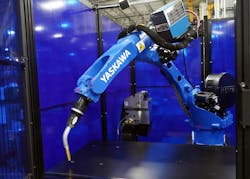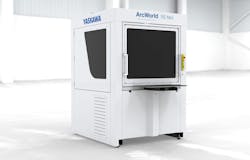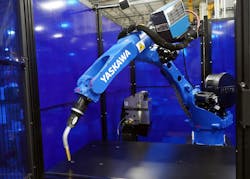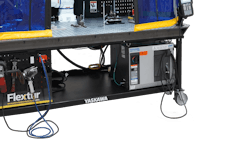Debunk Five Myths About Small, Efficiency Welding Work Cells
What You’ll Learn:
- Robot manufacturers have prioritized streamlining work cells to conserve floorspace.
- The initial cost of robotic entry is generally lower than anticipated.
- Introducing a robot greatly reduces the risk of welding-related injuries.
Regardless of floorspace availability, gaining the robotics advantage is easier to achieve than many small- to medium-size manufacturers realize. From greater productivity, safety and flexibility to noticeable cost and labor savings, these high-level benefits can be achieved within a relatively short payback period via the implementation of efficient and compact robotic work cells for weld processes.
Contrary to what some fabricators may think, space-saving robotic automation is a viable option that can optimize operations. While robot hesitancy for manufacturing production is waning, there are still several misconceptions that hinder its usage, especially where smaller work cells are concerned. To clear up the misperception, here are a few myth-busting concepts to encourage the use of high-performance robots for welding tasks.
Myth #1: Robotic Work Cells Take Up Too Much Space
A common misconception is that a robotic work cell will occupy too much floorspace. While traditional and more customized work cells tend to require more square footage, a high priority for robot suppliers and integrators is to offer highly capable robotic cells that use available floorspace effectively. Whether a fab shop is dealing with space constraints, or a Tier 1 company is measuring production value by square inch or foot of the factory floor, there are multiple space-saving equipment options that are adept at efficiently and consistently performing physically demanding tasks.
This is especially true for the high-mix production of small- to medium-size parts. Ideal for replacing or supplementing manual welding, such as pre-assembly before fabrication in larger robotic work cells, extremely compact systems—requiring as little at 1.4 square meters (15 sq ft) of floorspace and fully equipped with a high-speed robot and integrated weld package—are enabling quick changeover with safe and easy part loading and unloading.
Myth #2: The Cost of Entry for Robotics is Too High
Modern industry has ushered in an array of helpful technologies, enabling the development and production of more affordable yet capable robots and their peripheral tools. As a result, the initial cost of entry is generally lower than anticipated, enhancing potential financial gain and prompting faster payback over a targeted payback period. With consistent productivity, the majority of manufacturers can reach payback for capital investment, especially for efficiency work cells, within 18 months. To put things in perspective, the use of robotic automation gives existing welders a hand, frequently boosting a team’s productivity by 30%1. In turn, the increased capacity and throughout gained can make it easier for companies to reach their payback goals.
READ MORE: Collaborations Foster New AI-Powered Autonomous Inspection Solutions
To help right-size this benefit, there is a wide range of work cell options with diverse offerings. From basic features requiring more manual work by the operator (hinged doors or manual tooling, for example), to highly automated options that increase throughput on high-volume parts, fabricators should be confident that there is a configuration available to help suit their requirements.
While the efficiency level of smaller, pre-engineered cells may be a bit slower than larger work cells—due to features such as manual doors—the leg up that automation offers human welders is certainly enough to optimize production for tangible outcomes. This can hold true for collaborative welding systems as well. Human-collaborative solutions can come fully equipped with flash protection, fume mitigation and a smart Functional Safety Unit (FSU), enabling flexible and safe robotic automation at an affordable rate for maximum return on investment (ROI).
Moreover, robot suppliers and integrators are willing to work with customers to meet their budgetary goals—with financial experts available to help calculate the necessary numbers to steer manufacturers down a realistic path to investment that yields productive results. Along with this, unique options may be presented. From tax credits, payment plans and Small Business Administration (SBA) funding to Robots as a Service (RaaS) models, there are multiple financial avenues manufacturers can access to launch into robotic automation.
Myth #3: Robotic Automation Will Hinder Our Current Part Flow
The adage, “If it ain’t broke, don’t fix it,” comes to mind here. Manufacturers familiar with a completely manual process may question whether robotic automation can truly impact current production workflow and, ultimately, their bottom line. Yet, the successful implementation of high-performance robots has great potential to optimize part flow and overall productivity for a positive ROI.
READ MORE: 10 Tips for Automation Success
Similarly, fab shops and factory settings that currently have some level of robotic automation in place may hesitate to add more robots. In this case, subassemblies are most likely hand-welded, opening the door to quality issues and slower throughput than competitors. Adding a single robot arm to complement an existing work cell or adding a separate smaller system altogether can be highly effective at optimizing floorspace in these instances, improving quality and increasing output.
Along with this, pendant applications, such as the Universal Weldcom Interface (UWI), are helping programmers gain easy control of any weld process or parameter. By enabling full utilization of advanced capabilities from the welding power supply, items such as voltage, amperage and wire feed speed can be easily adjusted. Overall, this is a huge asset that small efficiency work cells can provide, enabling the utmost weld quality and product throughput.
Myth #4: Adding Robots to Production Will Take Too Long
Manufacturers with tight schedules for on-time delivery may opt out of robotic automation altogether for fear of halting production due to implementation downtime. However, suppliers and integrators work to make this process as easy and seamless as possible. From robot and work cell designs that facilitate fast integration to easy programming options that enable quick integration for less production downtime, keeping manufacturers up and running is a high priority for robot companies.
For example, many newer robots have a single power and control cable, reducing wiring time and increasing work efficiency. A variety of efficient welding work cells feature a common base for the robot and positioners (or tables) for fast setup and relocation. Where purchasing is concerned, most smaller cells have faster delivery times to market than larger work cells, so concerns of long lead times should be waylaid.
Myth #5: Robotics will Decrease the Safety of Current Operations
An experienced robot supplier or integrator will be able to guide manufacturers through a thorough risk assessment. Providing a detailed look into how the entire robotic system will mesh on the shop floor and interact with human workers, this process goes a long way toward addressing any safety concerns. From the robot and end-of-arm tooling to the part itself, there are many pieces of the robotic puzzle to consider. In fact, introducing a robot greatly reduces the risk of welding-related injuries such as arc flash, fume inhalation and most common workplace injuries like tripping or getting caught on stray parts.
Historically, being caught inside a larger automation line was perceived as a very precarious environment. Now, thanks to advanced tools and sensor technology, this risk is extremely low. Mitigating that risk even further is the use of compact welding work cells, as they offer more self-contained safety for easier compliance with local regulations.
READ MORE: Automate 2024 Wrap-up: Shifting the Robotics Paradigm to Flexible, Agnostic Solutions
Risk assessment compliant (with ANSI/RIA R15.06-2012 and other relevant ISO and CSA standards), work cells, such as the ArcWorld RS, come safeguarded, and the robot controller’s FSU uses “stand still” monitoring for robot safety signals. All doors are safety monitored. Solutions like this typically offer overhead LED lighting, sheet metal enclosures and light-reducing polycarbonate for arc and spatter protection. A built-in extraction hood for fume filtration is often standard, along with a four-button operator panel featuring E-stop for the utmost safety.
A Viable Path to Production
Smaller efficiency welding work cells can offer better floorspace utilization, provide a lower cost of entry into robotics, complement existing automation, accommodate tight delivery schedules and enhance safety compliance for increased worker morale. Therefore, manufacturers looking to supplement manual welding, mitigate safety risks or boost production throughput should highly consider their usage.
To facilitate a smooth implementation process, decision makers should execute a strategic plan. Each step should adhere to all relevant safety standards and account for any training current workers may need. Overall, companies that do this will soon realize the viable path to production that space-saving and efficient welding work cells can bring.
References
1. Essential Robotics in Workplace Statistics in 2023, Global Commerce Media, 2023
About the Author

Josh Leath
Senior Product Manager for Welding Robots, Yaskawa Motoman
Josh Leath is senior product manager for Welding Robots at Yaskawa Motoman. After spending over a decade as a product and brand manager for tools and test equipment lines, Leath joined the Yaskawa team in 2017. With nearly 15 years of experience, he works extensively with end-users to foster successful solutions that ensure customers succeed.




